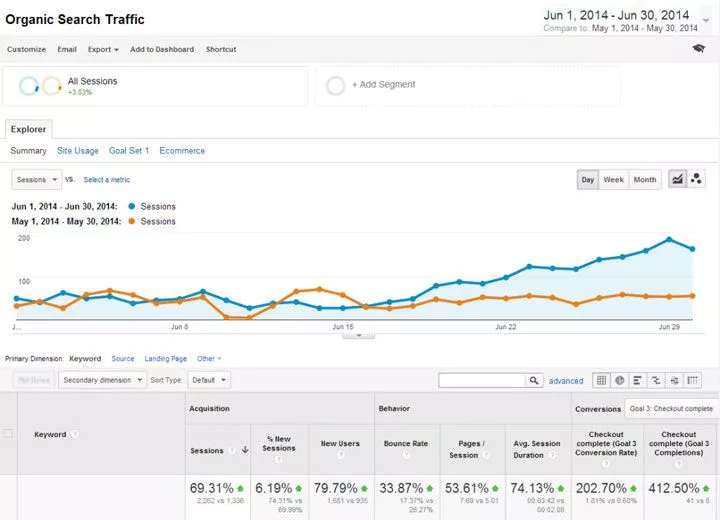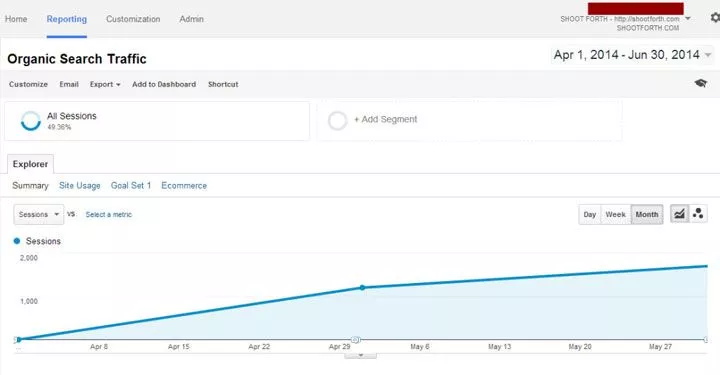An amazing client approached me to start a new e-commerce marketing project and to enhance their overall Internet marketing efforts — from social media to search engine, content marketing, and e-mail marketing. The website is hosted on Bigcommerce.
This article case study showcases the result produced so far on their organic search engine visibility using one of our critical search engine optimization (SEO) on-site audit strategies, meta tag optimization.
Seriously, is Meta tag optimization supposed to be something new and innovative? These are the first things to do when strategizing page optimization! – from a LinkedIn comment
Definitely, Meta tag optimization is not something new. However, this case study proves that basic, nothing new or innovative can still provide a significant impact on increasing search traffic and conversions – if done correctly and with care.
In fact, I’ve known lots of SEOs who do this technique but have never seen results.
Here’s what I believe: Mastering the basics will lead to advance.
Let this article guide you on optimizing the meta title and meta description since these are the main factors in how we have gained the results below.
The results:
- 69% increase in organic search engine visits
- 80% of new website visitors
- 412.50% increase in conversions (the most important)

Ok, ok, Roel. You’ve done great for your client, but I want to see proof that you also rock your own blog.

If you are not yet convinced about using the strategy that I am writing in this article, here’s a 3-month sneak peek at my organic search traffic graph since I launched my blog last April 29 (2 months ago) with only four articles posted and using this technique.
In fact, I have been using meta tag optimization to increase website traffic to other clients and to any industry.
Seriously, the above results from my client’s website on this article are produced using meta tag optimization strategy only, specifically the meta title and description.
Title Meta Tag
The title tag defines the title of a document and it is considered to be one of the most important on-page SEO elements. It appears on the search engine results page (SERP), on your browsers, and on external websites such as social media.
Whenever I do meta tag optimization, I use one of these five optimal formats:
- Unique Title | Keyword – Brand Name
- Unique Title – Keyword | Brand Name
- Unique Title plus Keyword – Brand Name
- Unique Title plus Keyword | Brand Name
- Unique Title plus Keyword
Using any from the above format works great on my campaigns, search engines, and users; however, I also consider the optimal length and width to get the most out of the search engines.
Google displays the characters that will fit into a 482- to 512-pixel display or around no more than 70 characters.
Screaming Frog SEO Spider is a great tool to easily see your title length and width. For an e-commerce website like what my client has, I try to limit them to the optimal length and width while making sure that they are unique and that they define the real title of their products’ content.
Getting the Keywords
Before you even do SEO, you should already have a long list of keywords that you wish to rank and be searched/known for. You can start optimizing your website’s meta tags from those keywords and get data that you can use for your meta tag re-optimization after (say 1 month?).
Whereas if you’re lucky and your website is at least 1 month old, you can use the data from the Google Webmaster Tools search queries and Google Analytics Organic Search traffic data to make your website more powerful on SERP.
Getting the Keywords: Sample Scene
Here’s a sample scenario: You sell chandeliers and of course, your website has a product page for it. Here’s a step on how to optimize the meta title based on my technique and process.
- Step 1: You have three options — Use Google Webmaster Tools, Google Analytics, or both.
- Using Google Webmaster Tools > Search Traffic > Search Queries, download the table and start from there.
- Using Google Analytics > Acquisition > Keywords > Organic, export the keyword data and start from there.
- Step 2: Keyword Combination
- Combine the Primary Keyword + Find a Keyword about chandelier from the search queries or exported keyword data that already gave you traffic, and match it to the content of the page, then use it.
- Step 3: Finalize
- Let us say that the page I am optimizing has the following descriptions:
- It is about a black chandelier.
- My main keyword is “chandelier”.
- The page is about modern chandeliers and chandeliers for home.
- Let us say that the page I am optimizing has the following descriptions:
I will finalize the title tag into the following:
Modern Black Chandeliers for Home — Brand Name

All the things and search phrases about the page can be seen in this optimized format; thus, making it a perfect title tag.
Description Meta Tag
A meta description tag provides a summary of web page content and also shows up in the SERPs.
Although Google announced that a meta description is not a factor in their ranking algorithms, they are still important to gain user click-through from SERP.
The meta description should be no longer than 156 to 160 characters and 926 pixels (width) so that search engines can fully display it. Again, Screaming Frog is a handy tool that can help you.
Creating the meta description tag is a little easier once you have the meta title for your page and the content inside it. You just need to put your main keywords on it, summarize the page content, and be mindful of the description length and width.
Important Notes
Both title and description tags should be unique and should avoid having duplicate tags.
Other Important Metas to Optimize:
- Image Alt Text
- URLs/Permalinks
Conclusion
Meta tag optimization is a simple on-site process that provides big and proven results, especially in gaining organic search engine visibility.
Always remember that meta tag optimization should be done with care and with thorough keyword research and analysis for better results, and to increase search traffic.
Roel Manarang is a seasoned digital marketer and designer with over a decade of experience helping businesses achieve online success. As the Director of Operations at Workroom, he combines his passions for design and marketing to deliver exceptional results for his clients. With a proven track record of delivering exceptional results for more than 100 businesses, Roel is a sought-after creative strategist specializing in world-class content, websites, SEO, and social media campaigns. Find him on Instagram, LinkedIn, and YouTube.
Subscribe And Receive Free Digital Marketing Tips To Grow Your Business
Join over 8,000+ people who receive free tips on digital marketing. Unsubscribe anytime.


